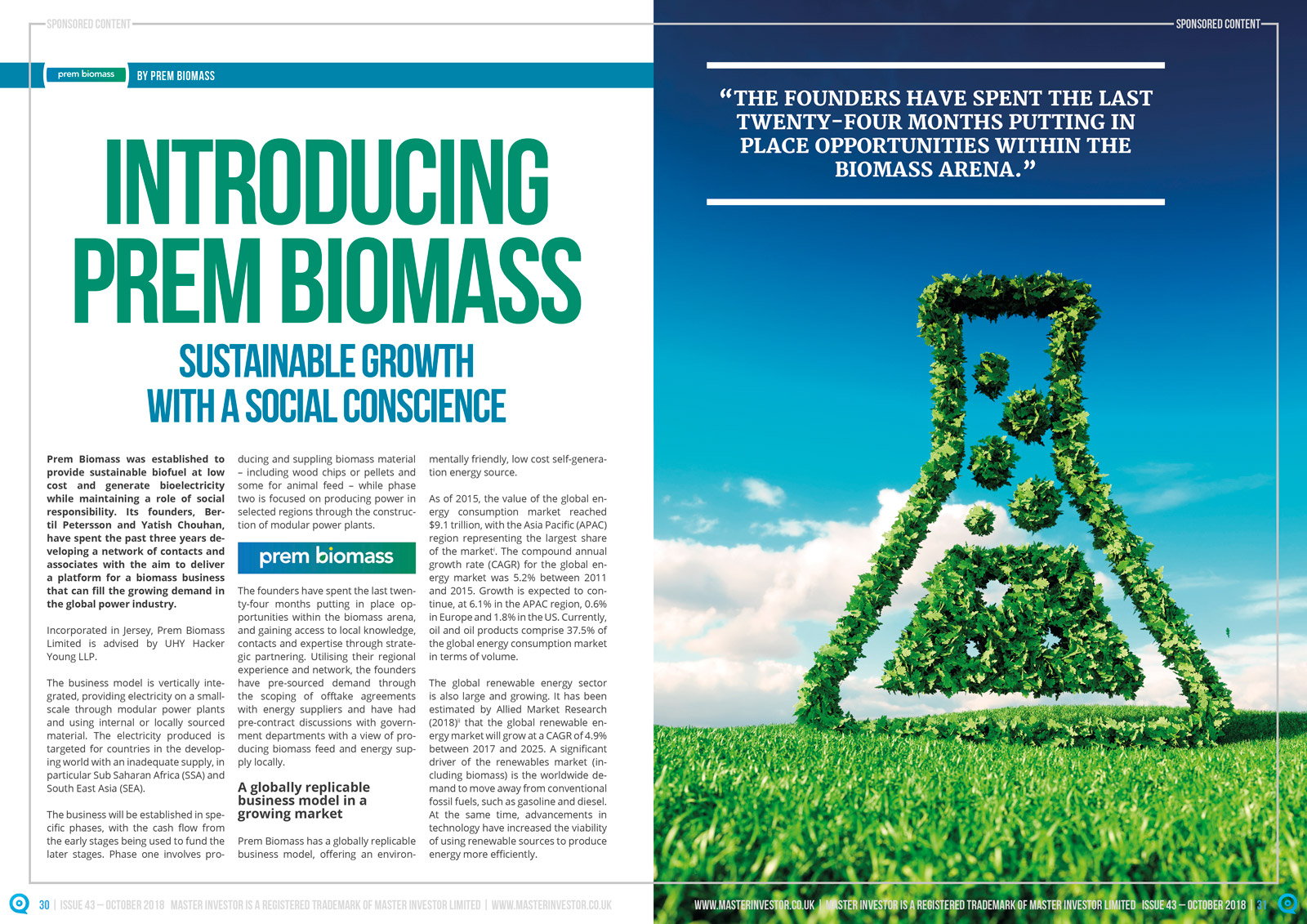Introducing Prem Biomass – MAGAZINE EXCLUSIVE (SPONSORED CONTENT)MAGAZINE EXCLUSIVE (SPONSORED CONTENT)

MAGAZINE ARTICLE
This article first appeared in Issue 42 of Master Investor Magazine.
Click here to download the article as a printer-friendly PDF

Get this article and many more – for free! |
Prem Biomass was established to provide sustainable biofuel at low cost and generate bioelectricity while maintaining a role of social responsibility. Its founders, Bertil Petersson and Yatish Chouhan, have spent the past three years developing a network of contacts and associates with the aim to deliver a platform for a biomass business that can fill the growing demand in the global power industry.
Incorporated in Jersey, Prem Biomass Limited is a biomass energy company, co-founded by Bertil Petersson and Yatish Chouhan and partnered with UHY Hacker Young LLP.
The business model is vertically integrated, providing electricity on a small-scale through modular power plants and using internal or locally sourced material. The electricity produced is targeted for countries in the developing world with an inadequate supply, in particular Sub Saharan Africa (SSA) and South East Asia (SEA).
The business will be established in specific phases, with the cash flow from the early stages being used to fund the later stages. Phase one involves producing and suppling biomass material – including some for animal feed – while phase two is focused on producing power in selected regions through the construction of modular power plants.
The founders have spent the last twenty-four months putting in place opportunities within the biomass arena, and gaining access to local knowledge, contacts and expertise through strategic partnering. Utilising their regional experience and network, the founders have pre-sourced demand through the scoping of offtake agreements with energy suppliers and have had pre-contract discussions with government departments with a view of producing biomass feed and energy supply locally.
A globally replicable business model in a growing market
Prem Biomass has a globally replicable business model, offering an environmentally friendly, low cost self-generation energy source.
As of 2015, the value of the global energy consumption market reached $9.1 trillion, with the Asia Pacific (APAC) region representing the largest share of the market[1]. The compound annual growth rate (CAGR) for the global energy market was 5.2% between 2011 and 2015. Growth is expected to continue, at 6.1% in the APAC region, 0.6% in Europe and 1.8% in the US. Currently, oil and oil products comprise 37.5% of the global energy consumption market in terms of volume.
The global renewable energy sector is also large and growing. It has been estimated by Allied Market Research (2018)[2] that the global renewable energy market will grow at a CAGR of 4.9% between 2017 and 2025. A significant driver of the renewables market (including biomass) is the worldwide demand to move away from conventional fossil fuels, such as gasoline and diesel. At the same time, advancements in technology have increased the viability of using renewable sources to produce energy more efficiently.
According to The International Renewable Energy Agency (IRENA), the demand for biomass will increase by 60% by 2030, but that growth figure could be double, depending on the introduction of new technologies and inventions in the industry[3]. 30% of biomass output will be used by local power industries, and a greater proportion will be used as feedstock.
| Would you like to learn more about Prem Biomass? Meet them at ‘Master Investor in focus: Investing into alternative energy’ on 11 October 2018 in London.
A selected few free tickets are still available. Book now to avoid disappointment. |
An important target market for Prem Biomass is Africa, with demand for electricity there expected to grow significantly – in fact, in the next 22 years, it’s expected to triple – and with supply failing to meet demand[4]. Ghana, in particular, presents an attractive opportunity, with seven million Ghanaians currently without access to electricity. Solar power shows the largest growth potential[5], but biomass also offers significant opportunities.
South East Asia is becoming increasingly influential in the global energy industry. The ten member countries of the Association of South East Asian Nations (ASEAN) collectively are the world’s seventh largest economy. Economic growth since 2000 has led to a 70% increase in energy demand, and the region now accounts for 5% of total global demand. The Cambodian market looks attractive for Prem Biomass due to a surge in foreign investment and new legislation around foreign ownership. There is a government-mandated programme to increase power production, and feed-in-rate legislation that supports a long-term operating basis for investment commitments. The availability of land for biomass production also makes it an attractive market.
One of Prem Biomass’s goals is to provide services in-line with local needs and customs. It plans, in consultation with the locals, to identify areas of improvement and then develop those areas using locally sourced resources. As part of its corporate social responsibility, the company plans to use Napier grass, animal feed and bioelectricity to benefit the locals and the environment.
The biomass opportunity
As of 2012, biomass accounted for 14% of the world’s energy consumption[6]. More specifically in Sub-Saharan Africa and South East Asia, biomass energy use accounted for 74% and 29% of total energy consumption.
Future expansion is expected to come from mini- and off-grid operations that will deliver between 100kW-1,000kW per unit[7]. Expansion of existing grid systems is more likely in densely populated urban centres, where the cost can be offset by new customers coming on line.
The biomass industry has grown significantly over the past 10 years and is now considered to be in its second generation phase, according to a study by the United Nations (UNCTAD)[8]. With biomass, there are clear divisions in the use of ethanol and other agricultural bi-products. The ethanol market is focused on the US, Europe and Brazil, while in Africa there is virtually no production of ethanol, while agricultural bi-products are used instead. Biomass is the leading source of feedstock for cooking stoves in the equatorial region of Africa and S-E Asia. Pelletising the agricultural waste available in these areas is a long-term goal for international support agencies. Napier grass is considered a useful strain, as it is the highest yielding, three times that of the next best (sugarcane). The cost of Napier grass pellets, at $0.06 per kWh, makes it a competitive choice.
Although there are many sources of biomass materials, Prem Biomass has chosen Napier grass as its main focus owing to having a high net calorific value: 3,895 Kcal per kg with the ability to produce three to four crops per annum.
Prem Biomass’s marketing activities are carried out largely through face to face direct sales. This is achieved through identifying suitable partnerships in-country, and then working on building up solid relationships with these groups. It has selected two countries in each geographical region to start its operations with similar characteristics.
Progress to date and future plans
Cambodia and Ghana both have stable investment climates, pro-government support for adopting renewable energy with legislated pricing structures, minimal red-tape, local demand and local renewable expertise.
The business will obtain 10-year offtake agreements that can provide security of return for investors. These are to be agreed within the first three-four months following the investment.
Prem Biomass’s financial projections show profitability from the second year of operations. Management has structured the investment in phases to generate early sales revenue, with a focus on controlling costs. We believe the market timing is perfect, as this is a developing market, with strong demand, government support, and locally sourced feedstock and energy that is cheap and simple to produce.
Phase one’s focus is to produce and supply biomass material, whereas phase two is to focus on the construction of modular power plants and supply of biomass material.
Prem Biomass will provide agriculture material, including wood chip and Napier grass pellets for power plants and other bi-products. There will be an initial investment in Cambodia to set-up a wood chip facility to meet existing biomass demand in Korea and Japan as per off-take agreements.This will be followed with further investment in Ghana with a move into the cultivation of Napier grass and the installation of a processing plant that will meet local demand as well as the increased demand from Korea and Japan.
Phase two consists of the construction ofmodular power plants for power production in rural areas where there is a high demand. The first stage is to be in Ghana, with the installationof a small-scale 2MW, modular power plant with future demand required of 25MW. The aim is to propose a programme that can provide flexible and scalable power units to this segment of the population. The Cambodian Government has requested a biomass power plant and indicated feed-in-tariff agreements. The Cambodian market looks very positive for Prem Biomass due to a surge in foreign investment and new legislation around foreign ownership.There is a government-mandated programme to increase power production, and feed-in-rate legislation that supports a long-term operating basis for investment commitments. The availability of land for biomass production also makes it an attractive location.
The total investment opportunity of US$10,000,000 is to be used to execute the initial business plan over eighteen months. US$2,000,000 will be used to execute phase one of the business plan over first six-to-twelve months. US$8,000,000 will be used to execute phase two of the business plan from six-to-eighteen months. The investment offering is common stock, preference shares, convertible loans or a combination of the above, with a negotiated term.
Prem Biomass will generate revenues through selling electricity to the grid for a guaranteed feed-in fee structure and by selling pellets or wood chip to power companies and feedstock to local farmers. Although Napier grass is an important revenue stream, over the five years of this business plan, sales of power to the grid and woodchip are intended to surpass revenues from this source. The projections indicate EBITDA positive in year 2.
Summary
- Cash-rich high yielding investment and conservative yield estimates provide significant upside opportunities
- ‘Early bird’ Investment opportunities
- Strong governmental support for projects in the power sector and renewables
- Legislated feed-in tariffs for electricity as of 2016 guaranteeing sales
- Securing animal feed pellets is a Ghana Government supported national mandate
- Diversified, low risk marketing plan, including power purchase agreements with government and telecommunication operators
- Highly fertile arable land with the ability to irrigate and achieve excellent crop yields
- Low overheads through significant savings in land rentals and labour costs
- Demand for second generation biofuels are high in Japan, South Korea and Europe
Investment Highlights
- Vertically integrated business model
- Positive environmental and social impact
- High value and high margin
- EBITDA positive from year 2
- Highly experienced management team
- Scalability: investment in second phase is a planned replicable business model to produce power in rural areas with greatest demand
- Low entry cost of land
- Expansion opportunities: targeted growth to 25MW with further demand for 3-400MW.
- Significant opportunities in downstream partnerships
Contact
Rob Starr, Director of UHY Hacker Young LLP Chartered Accountants
Quadrant House, 4 Thomas More Square, London E1W 1YW
Email r.starr@uhy-uk.com
Prem Biomass Limited, c/o Fairway Group, 2nd Floor, The Le Gallais Building, 54 Bath Street, St Helier, Jersey, JE1 1FW
[1]Marketline (2016) Energy Consumption Global Industry Guide
[2]Allied Market Research 2018 Renewable Energy Market by Type and end User
[3]IRENA, 2014 report
[4]World Energy Outlook 2017 Summary
[5]IEA Africa Energy Outlook, 2014, page 185
[6]World Energy Council 2012
[7]IEA Africa Energy Outlook 2014
[8]UNCTAD (United Nations Conference on Trade and Development)

|
Comments (0)